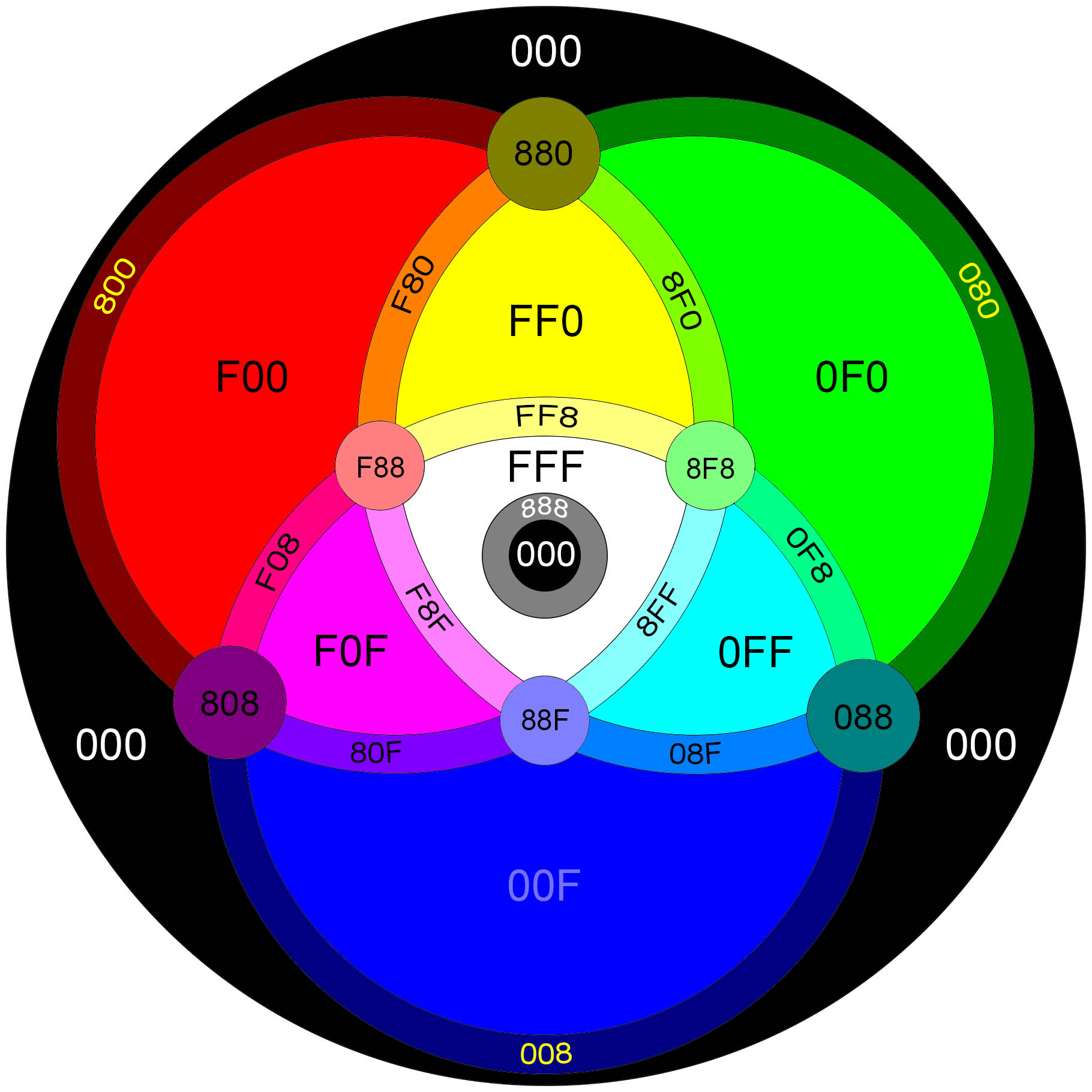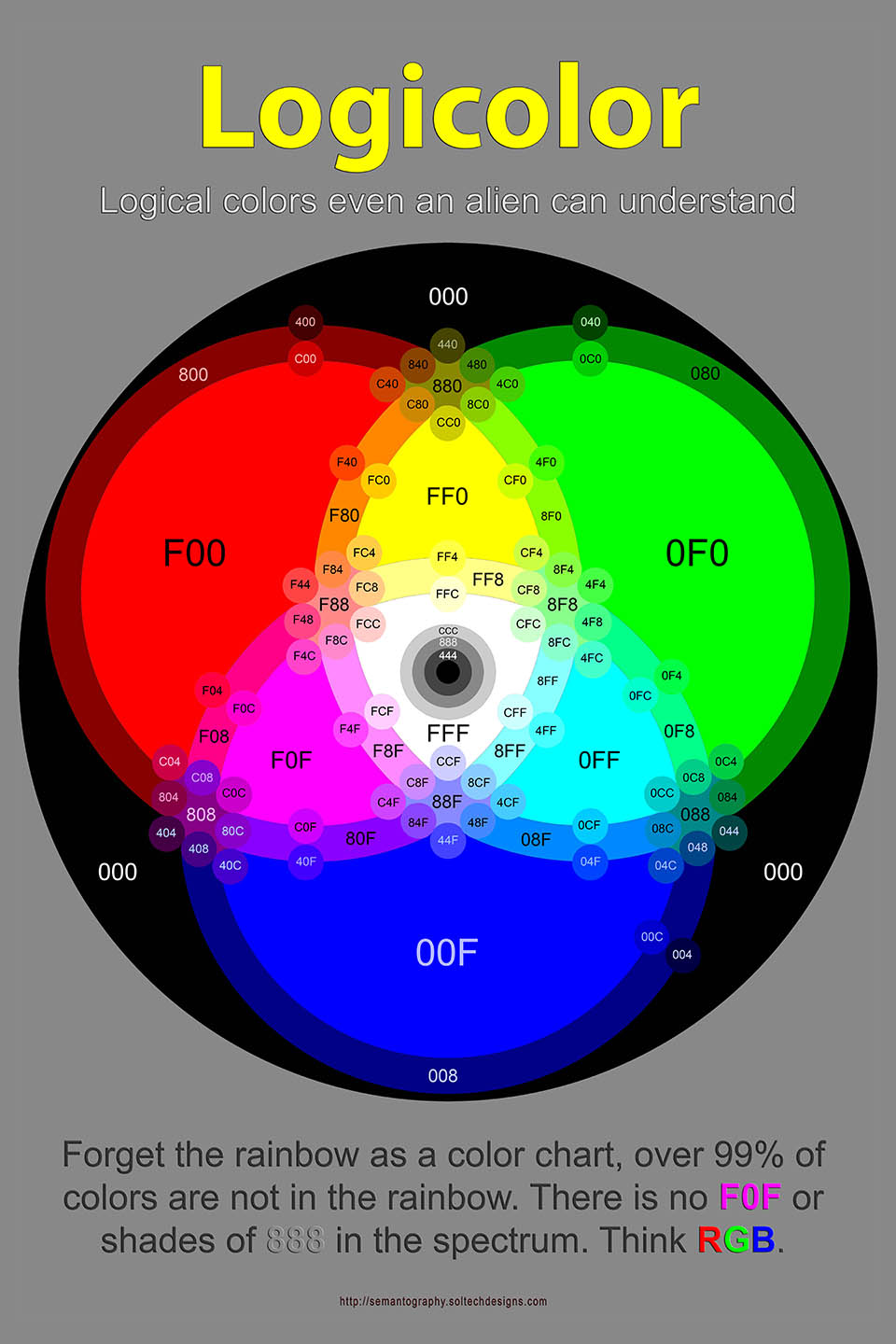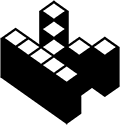
SATURDAY, JAN 30, 2016

Logicolor
Logical Colors for an Illogical World
Cross cultural Logicolor chart and names
Eric Lee, A-SOCIATED PRESS
TOPICS: COLOR NAMES, UNIVERSAL COLOR LANGUAGE
TUCSON (A-P) — Logicolor is a written language that uses three letter words to name up to 4,096 colors. How you pronounce the letters in your native language is irrelevant. The number of colors in a rainbow as seen by humans varies, or rather the number given names and perceived as separate varies. Most people see somewhere between 4 and 9 colors in a rainbow. You decide:

In the West, per tradition, there are 7 colors, namely:
1 #FF0000 red
2 #FF7F00 orange
3 #FFFF00 yellow
4 #00FF00 green/lime
5 #0000FF blue
6 #4B0082 indigo
7 #8B00FF violet
Show people a dozen or so different "shades of red," and all will have an opinion as to which is the "real red" whose name will vary depending on which of over 6,000 languages the viewer speaks. Even in the same language, names will vary as some will insist that #008000 is "green" and #00FF00 is "lime." The #number is in hexadecimal which allows over 16 million colors to be named using "0123456789ABCDEF" symbols.

Black is the absence of light and so is #000000, and white is the presence of all visible wavelengths of light and so is #FFFFFF. For some purposes 16,777,216 possible hex color code combinations is enough. For natural language purposes somewhere between 4 and 500+ names are considered needed. If you see only four colors (the number of color words in some languages), other members of your tribe are likely to agree with you almost all the time that a given color's name is the correct one to use. Much beyond that and you enter into the land of Color Babel.
I see six rainbow colors, but four seems reasonable at a glance and maybe seven or nine by staring. Still, in English alone there are over 500 color names that somewhere someone considers minimal. For international, intragalactic, transtemporal purposes, naming colors and picking from them a few names for practical social purposes becomes an interesting problem. For the purposes of science and computer graphic designers the RBG hex codes provide a six character code name for more colors than the human eye can see. Six character words numbering in the millions is impressively economical and precise. Picking the "seven colors of the rainbow" and giving them English names for universal use is a bad idea on so many multiple levels that it is not even the wrong. Still, for some purposes, we need a few color names for practical use.
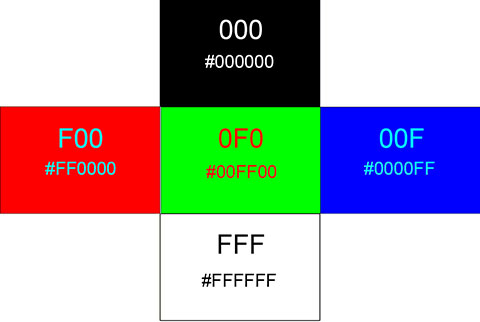
While we can argue whether "white" and/or "black" are colors, naming them is easy. Black is #000000 or 000. For social purposes 000 is short and precise ('it was pitch 000 outside...').Each character represents the presence or absence of "Red Green Blue" or RGB to you computer geeks. Some combination of RGB creates "all" colors, or close enough, with each value ranging from 00 to FF hex or 0 to 255 decimal. In hex only two symbols are used for each primary color and by convention two are always used, hence #4B00E2 is a color. In a short list of colors, three characters are enough, so black is 000.
White is #FFFFFF or in shortform FFF. The "primary" colors are red, #FF0000 or F00, green, #00FF00 or 0F0, and blue, #0000FF or 00F. Hence roses are F00 and violets are 00F rather than 90F. Once you get the idea of RGB and learn the 16 arbitrary "0123456789ABCDEF" symbols that most humans who use computers already know, you can name from 5 to 4,096 colors using three letter words. A starting point is to learn a five color international vocabulary above (000, F00, 0F0, 00F, FFF) that uses two symbols.
Let's add a few more, the secondary FFcolors: FF0, 0FF, and F0F. Three more colors gives eight colors which may well be enough for most purposes.
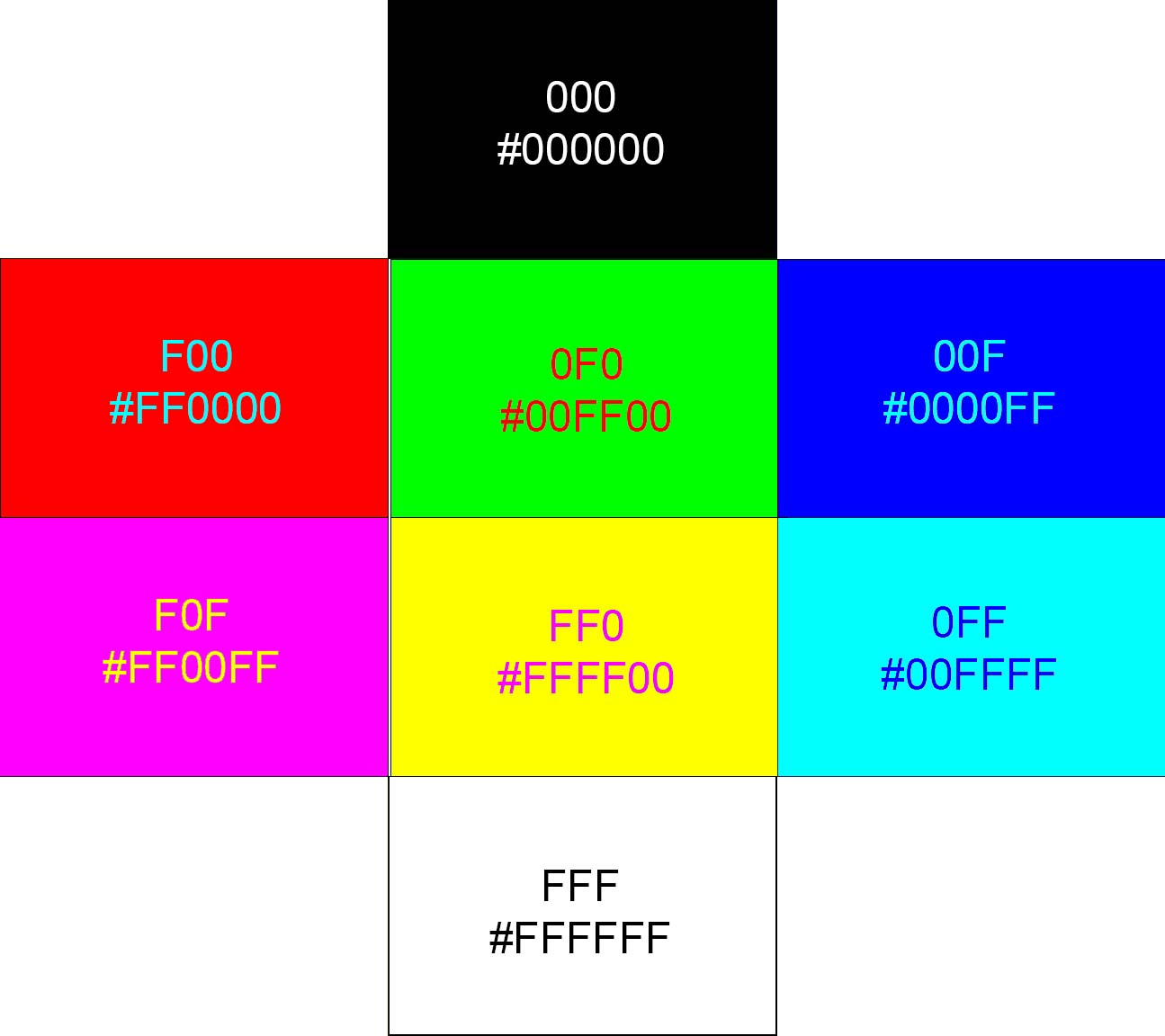
0 000 #000000 [black, nigra, negro, noir, schwarz, μαύρο,......... ]
1 F00 #FF0000 [red,......................................... 700 nm]
2 FF0 #FFFF00 [yellow,...................................... 580 nm]
3 0F0 #00FF00 [green,....................................... 510 nm]
4 0FF #00FFFF [cyan/aqua,................................... 490 nm]
5 00F #0000FF [blue,........................................ 440 nm]
6 F0F #FF00FF [fuchsia/magenta,.................... not in spectrum]
7 FFF #FFFFFF [white,..........................also not in spectrum]
You can call them what you will, but after a relatively short and not too steep learning curve, the eight colors could be learned, given a precise name/definition, and the Babel of natural language and the vagaries of individual human evaluation can be bypassed.
For the international language of Semantography, Bliss proposed using the colors of the rainbow and numbering them 1 through 7.
1 #FF0000 red
2 #FF7F00 orange
3 #FFFF00 yellow
4 #00FF00 green/lime
5 #0000FF blue
6 #4B0082 indigo
7 #8B00FF violet
The problem is that both the number of colors and the names to call them is at best a matter of tradition. A rainbow arises from a combination of refractions and internal reflection in droplets of water (not perfect spheres) and not all colors are present in a spectrum, whether made by a prism or rainbow. The colors of a rainbow vary with the rainbow and are processed dynamically by the atmosphere, favoring red and blue while minimizing green. There is no F0F color in the rainbow as it is a blend of red and blue which are on opposite sides. Logicolor approximation: F00 F80 FF0 0F0 0FF 00F 808 to the rainbow colors:
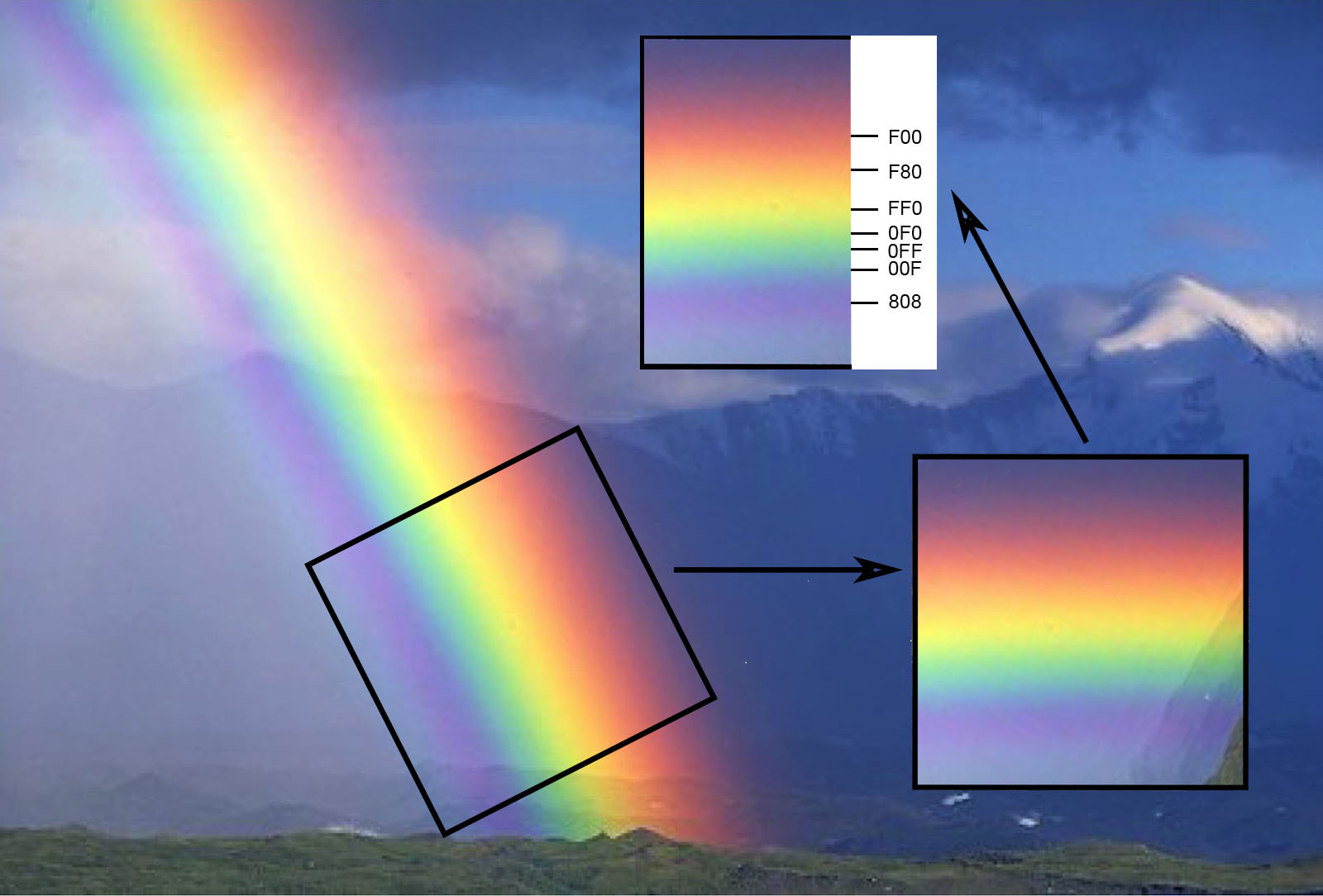
You could use a picture of a rainbow and point to one color location for each of the seven colors but no two humans would agree as to precisely where to point and many colors are missing. The human eye sees wavelengths between about 390 and 700 nm, and can distinguish between about 10 million colors, but the spectrum covers only about 165 colors making it a poor color chart. For a logical language like Semantography a logical way to name colors is needed. Consider RGB lite: 000, F00, 0F0, 00F, F0F, 0FF, FF0, and FFF.
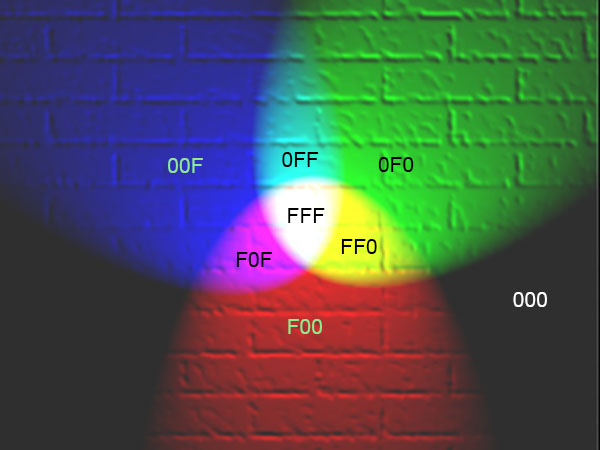
So, what's 000 and FFF and F00 all over? If more colors are needed, add one more symbol for 19 more colors. The symbol would be for the value between #00 and #FF which is #80. To simplify, boil down to 8. So between #000000 and #FFFFFF you get "gray" or "grey" #808080 (or #888888) or just 888. So instead of a gray day, it's an 888 day. Between black and blue you have "navy blue" #000080 or 008, which is (000 + 00F)/2 averaging 008. Total names are now 27, which will take longer to learn, but not as long as learning the Esperanto names as all natural and constructed spoken languages use strings of arbitrary sounds and perhaps symbols to write them (some languages have no written form). In our three character three position color names the first is alway "red" F00, so F00 + FF0 would be mostly red (F80 = "orange") with some green added, but not enough to make yellow. Once RGB is understood, the names can be figured out. Each triplet is like an ideograph: position and value tell the story.
In the following chart all 27 colors are shown. Click and download to print. Imagine three beams of RGB light outside of which is no light: 000. In the middle of the screen is a hole which reflects no light and so is 000. Between FFF and 000 is 888. The other boundary colors are shown and the small circles show combined opposing color blends, so 880 is both 000 - FF0 and F00 - 0F0. The 8 (F + 0 = F, F/2 = averaged value of 8), again, is the value between 0 and F.
If 27 colors are not enough, add 4 and C for colors between 0 & 8 and 8 & F. Between FF0 and FF8 would be FF4. New colors could be FFC, 440, and FC4...for a total of 125 colors. Perhaps a poster showing the boundary colors between those above would be of interest. For more, add 2, 6, A and E for 729 total colors. Beyond that, the human eye and brain doesn't care much. But for the discriminating, use all characters 0 to F for 4,096 colors. The human eye can tell the difference between each, though the felt need to name them all may be excessive. Still, using three character words, you have F00, F01, FA3, F9E.... Perhaps a new game could be "Name that Color!" Beyond three letter words you have to use six character words.
So we have a logical color language for which there is a logical need but no commercial or popular need, so Logicolor is unsellable even figuratively speaking. It could be used by one person for private satisfaction, or for communication between two or more users of the Logicolor language. To communicate with someone in the far future, however, who may well speak no current language, some language for color and everything else is needed. That no one wants to learn a new language to chat with their friends today is irrelevant. If the idea of white, black and RGB is conveyed, and a few symbols are added, the rest follows.
0..............F 23 = 8 named colors.
0.......8......F 33 = 27 named colors.
0....5....A....F 43 = 64 named colors.
0...4...8...C..F 53 = 125 named colors.
0..3..6..9..C..F 63 = 216 web safe colors.
0.2.4.6.8.A.C.EF 93 = 729 colors.
0123456789ABCDEF 163 = 4,096 three character colors (000, 001...FFE, FFF).
000000 to FFFFFF 2563 = 16,777,216 six character colors.
Shades of gray in:
27 Colors, 1 888
125 Colors, 3 444 888 CCC
729 Colors, 5 222 444 888 AAA CCC EEE
4096 Colors, 13
111
222
333
444
555
666
777
888
999
AAA
BBB
CCC
DDD
EEE
Using 05AF to create 64 names is possible, but as 8 has already been used, going to 048CF names also adds two symbols but gets 125 names. The number between between 00 and 88 is 44, but between 88 and FF isn't CC (it's C3), yet close enough, so between 8 and F is C. If more colors are needed, add values between the already used, so skip the web safe option and go to 729 colors. The three character names are short forms for the six digit hex values, so 888 is #888888. Gray can also be #808080, an ever so slightly darker gray, so while the missing digits could be zero, think of the missing digit as the same digit, so C48 is #CC4488.
A prism-spectrum is simpler, more "pure" than a rainbow. Less red but still no fuchsia/magenta FOF. An average human can only distinguish about 165 colors in a spectrum, about 0.00165% of discernible colors created when all possible colors are combined. There are no shades of gray for example and so on.

The visible spectrum:
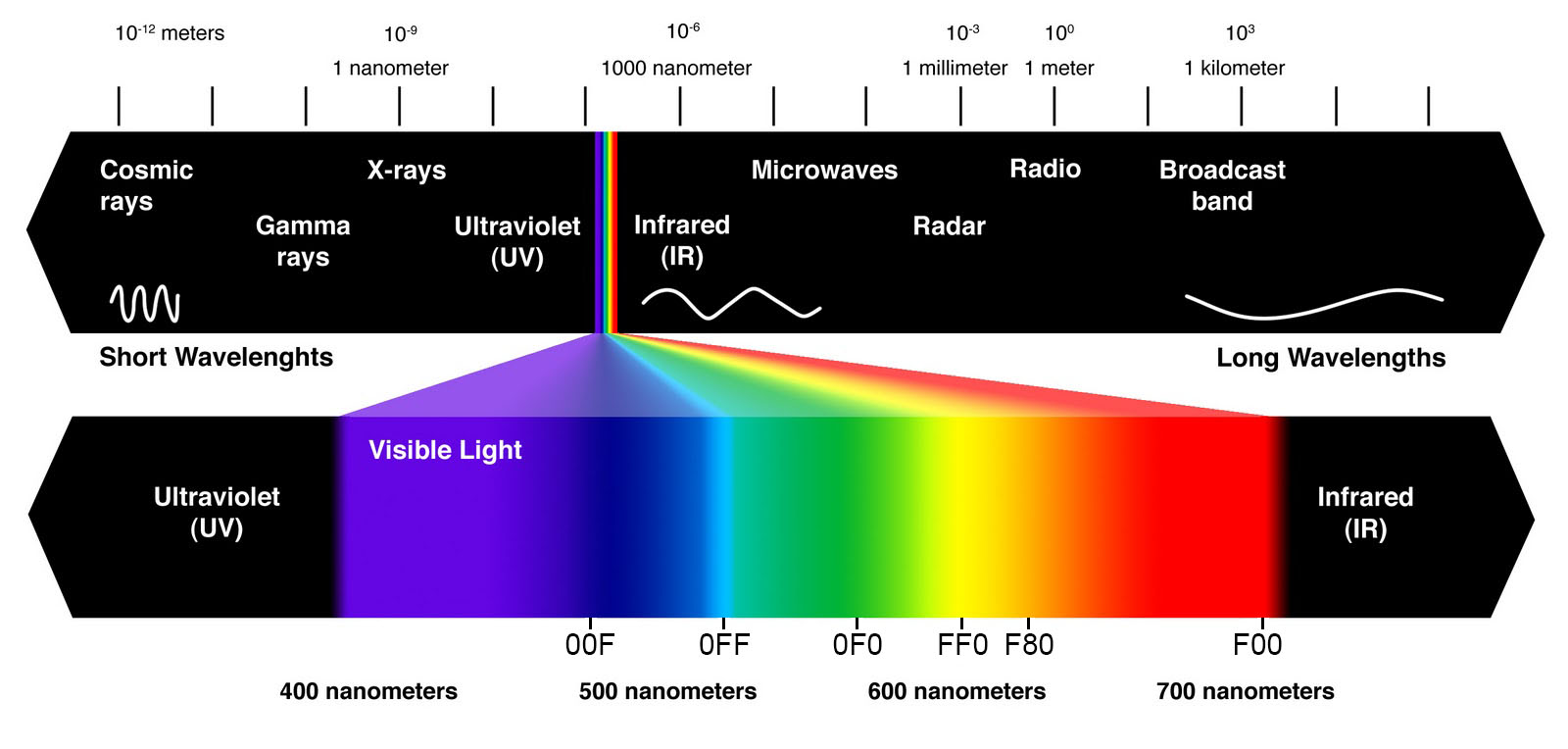
Simple with one number per color, values from 390 to 700, but most colors are not in a spectrum. The human eye can see a difference between colors that differ by 1 nm in the middle of the spectrum, but only sees differences between two colors about 10 nm apart in the red and blue ends, so that is why the red and blue ends appear so wide. The human brain sees bands of color, but no wavelength bands exist, so the only color bands are in our minds.
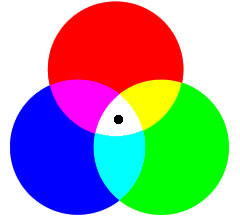 Instead of spreading out white light, combine red, green, and blue which are in the spectrum. All colors will not be created by three beams of overlapping RGB light, but the three new secondary colors jump out clearly and distinctly and there is no wiggle room for disputation. With 000 and FFF, there are eight RGB primary colors as seen when the three RGB beams overlap to create them. Put a mirror in two color areas and reflect so the two reflected beams combine and a new color is created, such as F00 + FF0 to give F80 as orange. Combine all color pairs and get 19 new colors for a total of 27. An experiment for laterday Newtons would be to spread sunlight using a prism and, in a very dark room, put circular mirrors as best one can in the red, green, and blue areas. Reflect them to overlap. Put smaller mirrors in each color and combine. In this way you could create F0F magenta or F8F from sunlight.
Instead of spreading out white light, combine red, green, and blue which are in the spectrum. All colors will not be created by three beams of overlapping RGB light, but the three new secondary colors jump out clearly and distinctly and there is no wiggle room for disputation. With 000 and FFF, there are eight RGB primary colors as seen when the three RGB beams overlap to create them. Put a mirror in two color areas and reflect so the two reflected beams combine and a new color is created, such as F00 + FF0 to give F80 as orange. Combine all color pairs and get 19 new colors for a total of 27. An experiment for laterday Newtons would be to spread sunlight using a prism and, in a very dark room, put circular mirrors as best one can in the red, green, and blue areas. Reflect them to overlap. Put smaller mirrors in each color and combine. In this way you could create F0F magenta or F8F from sunlight.
Similarly combine the 27 colors for more and so on as needed. For most purposes 8, 27, 125, 729, or 4,096 colors should be enough. If learning 8 or maybe 27 new color names seems like an excessive task, try learning the Esperanto or Hopi (or 6,000+ other languages) names for colors. So, let there be FFF.

